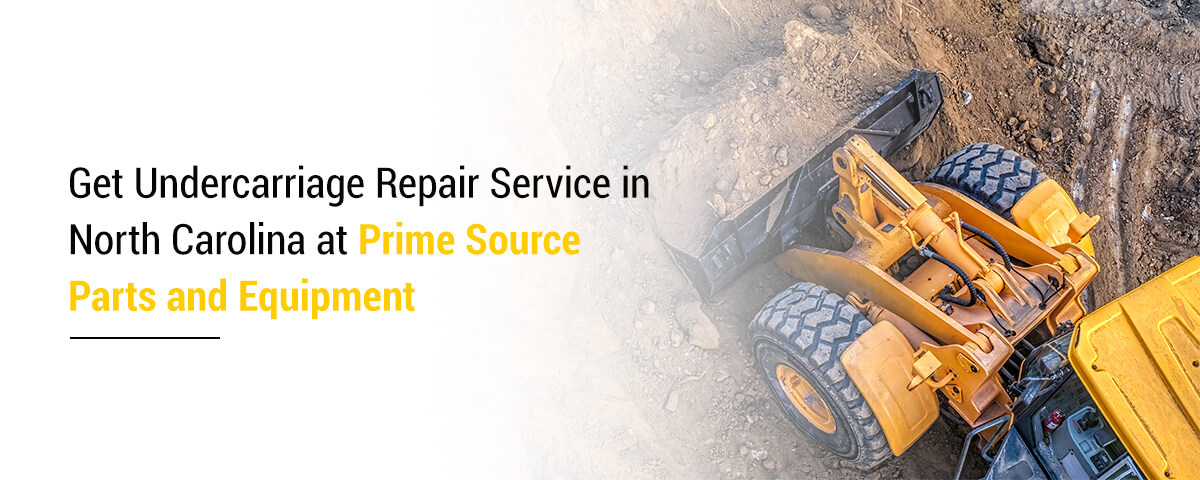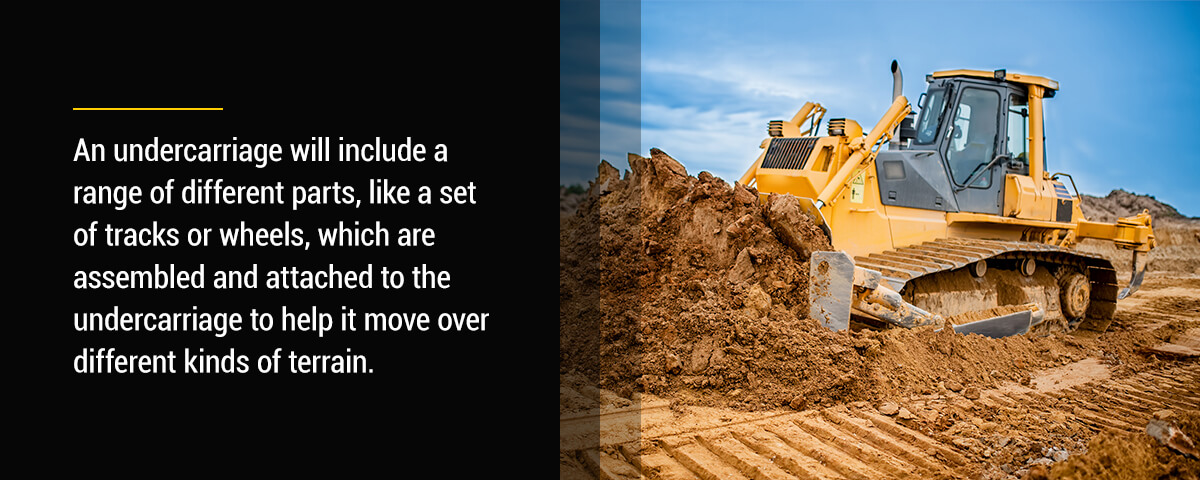
The undercarriage is a crucial part of heavy equipment. This equipment component is incredibly strong, built to withstand some of the toughest conditions. However, damage to heavy equipment, and the undercarriage especially, isn’t always avoidable. There are various factors that can lead to undercarriage damage over the years.
Here’s a look at some of the most common causes of undercarriage damage and how to fix them.
What Is Undercarriage Damage?
The undercarriage of heavy equipment refers to the supporting framework underneath a piece of heavy machinery. There are various types of undercarriages, including rubber track undercarriages and machinery steel undercarriages. An undercarriage will include a range of different parts, like a set of tracks or wheels, which are assembled and attached to the undercarriage to help it move over different kinds of terrain. Other key components include frames, pins, idlers, rollers, sprockets, bushings and links. This component is crucial to a piece of equipment’s functionality.
Undercarriage damage is any damage or harm that has occurred to the supporting structure underneath a piece of heavy equipment. Considering how essential the undercarriage is to heavy machinery, damage can be a huge cause of concern, accounting for some extensive, costly repairs. There are a number of different factors or conditions that can cause harm to machine undercarriage.
What Causes Undercarriage Damage?
Although a certain level of undercarriage damage is inevitable for most pieces of heavy equipment over time, it’s still important to be aware of the main causes to prevent as much damage as possible.
What does undercarriage damage mean? Here are four of the most common causes of heavy equipment undercarriage damage:
1. Rough Terrain
One of the more obvious causes of undercarriage damage is rough or uneven terrain, as it’s usually easy to tell when your equipment has driven over large holes or dips in the ground. Worksites often feature rough patches, which can have a significant impact on heavy equipment. Bouncing along the ground while driving over a hole or other rugged, uneven surfaces can cause cracks in the undercarriage, which can lead to leaks.
Another harmful aspect of rough terrain can be rocks and other types of construction site debris. Whenever you strike rocks, rubber tire pieces or any other objects or debris while operating the machines, it can cause damage to the undercarriage. Rocks can fly up and cause punctures or knock bolts and other parts loose. That’s why it’s important to always drive with caution on sites with lots of debris or unsteady, uneven terrain.
2. Water and Moisture
Although the undercarriage — like the rest of the machine — is covered with a protective finish for water exposure, the finish won’t always be effective. Considering that the undercarriage usually experiences more scratches while the equipment is at work compared to the rest of the parts, the protective finish will wear off even quicker.
Therefore, when the undercarriage gets exposed to water too often without the chance to dry properly, the moisture will start to interact with the metal and lead to corrosion. Eventually, corrosion leads to the metal weakening and premature wear.
3. Mud Residue
Mud residue can be a huge problem in some areas and cause a lot of harm to the undercarriage. If the mud doesn’t get washed off the machinery and its undercarriage properly, it can hold moisture, which will eventually lead to seal and bushing failure.
Mud and other debris can also build up in treads and lead to excess wear by adding weight to the equipment.
4. Improper Operation
Using heavy equipment beyond its operating capacity can cause stress to its undercarriage. Constant use on sloped surfaces requires a large amount of power that puts strain on track shoes, rollers and segments. Making sharp movements instead of wide turns quickly wears out tracks.
How to Prevent Undercarriage Damage
Premature equipment failure is often a result of poor maintenance. Perform regular inspections on your equipment’s undercarriage to identify issues before they become major problems and prevent many issues from arising in the first place. Damage prevention includes:
- Regular Inspections: Inspect your equipment before and after each use, paying attention to parts such as the bearing seals, bolts, chains, rollers, segments and rock guards. As you inspect, look out for any parts that are worn or missing. In addition, stick to a regular plan for greasing parts, tightening bolts and performing test drives on new terrain, so you’ll always have equipment that operates at its best.
- Cleaning: At the end of each day, give yourself enough time to clean your equipment. Clear out any debris before it hardens or freezes overnight. Use a shovel to break down large chunks of debris, and follow up with a power washer to clean hard-to-reach places.
- Careful Operation: Avoid human error by only using your equipment according to its exact specifications. Be aware of the types of terrain you operate on, and clear the worksite of mud and harsh gravel whenever possible.
- Scheduled Maintenance: Follow your equipment manufacturer’s suggested maintenance schedule. Regularly bringing your machines to the professionals, even when they’re operating normally, can help you avoid minor issues turning into costly problems.
- Seek Professional Guidance: Ask for a professional to measure the wear on your undercarriage every 2000 hours of operation
How to Fix Undercarriage Damage
If you realize your heavy equipment’s undercarriage is damaged, or you suspect you’ve caused an issue by driving over uneven terrain or pushing the equipment beyond its capacity, stop operations immediately. After you’ve safely moved your piece of equipment out of the way of site hazards, inspect the undercarriage for any visible damage. If you see oil from bushings or your equipment is noisier than usual, vibrating or difficult to control, immediately seek professional help.
Regardless of the amount of damage, it’s always advised to get the piece of equipment assessed by a local certified technician after any incident. Your heavy machinery is an investment, and you’ll want to make sure it operates at its best for as long as possible. Undercarriage damage can often be fixed. Professional maintenance gives you peace of mind so you can get back to work knowing your machine is in good hands if other issues arise.
Looking for Undercarriage Repair Service in North Carolina?
At Prime Source Parts and Equipment, we offer fast and effective repair services to help you with your specific heavy equipment undercarriage needs. As experts in the industry, we understand how crucial it is to get heavy equipment machinery up and running again as soon as possible. Our shop is equipped with two track presses to allow for quick repairs to keep our customers up and running.
Contact us today to find out more about our expert undercarriage repair and maintenance services.


